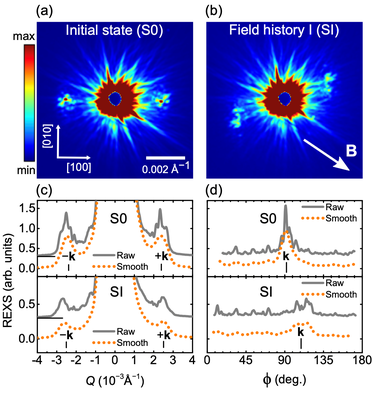Do you want to keep up to date? Subscribe to our newsletter. 1 mail every 2 months! |
 |

Figure 1. Schematic illustrations of the helicoidal (left), cycloidal (middle) and anti-skyrmion spin structures in non-centrosymmetric materials belonging to D2d point group.
Cerdanyola del Vallès (Barcelona), 23th of December 2022. Atomic magnetic moments in materials with unpaired electron spins can be subjected to interactions. Among these interactions are dipolar and exchange coupling, which largely govern the relative orientation of neighboring spins. Classic Heisenberg exchange aligns spins parallel or antiparallel. Dipolar interaction, in turn, leads to magnetic domain formation and gives rise to transition regions called domain walls where spins rotate forming Bloch or Néel walls. Anti-symmetric exchange terms like the Dzyaloshinskii-Moriya interaction (DMI) stabilizes structures of higher complexity such as helical and cycloidal spin modulations, and more complex non-coplanar structures such as skyrmions and anti-skyrmions with topological protection (see Fig.1). Domain walls and the more recently discovered skyrmion and anti-skyrmion states are currently of high interest, as a potential base for faster, energy-efficient memories and spintronic technologies.
Recently, multiple intriguing phenomena have been discovered in tetragonal Heusler compounds, where D2d symmetry sets a unique interplay between DMI and magnetic dipolar interaction. In the prototype D2d compound Mn1.4PtSn, this has allowed the stabilization of exotic spin textures such as first-reported anti-skyrmions [1] or elliptic Bloch-type skyrmions [2,3]. In the crystal structure of the Mn1.4PtSn alloy the atomic layers are stacked in a way that causes the DMI vector to rotate within the ab plane such that it is parallel to the Mn-Mn bonds along the crystallographic [100] axes and perpendicular to the bonds running along [110] (see Figure 1). According to theory, the direct consequence of this is that the Bloch-type helicoidal modulations are favored for propagation vectors Q along [100], whereas the propagation vectors of [110] would correspond to the Néel cycloids [4]. The rotation sense of the spin spirals is also discerned in the internal structure of the anti-skyrmion which represents a double-k superposition of two proper-screw helices and two cycloids rotated by 45◦ with respect to each other, as highlighted in Figure 1 [1]. In addition to DMI, dipolar interactions play an important role for the plethora of field-induced phases in the D2d Heusler compound Mn1.4PtSn and their characteristic periodicity [2]. While less attention has so far been given to the low-field spiral state, this remains extremely interesting as a simplest phase scenario on which to investigate the complex hierarchy of magnetic interactions in this materials family.
An international collaboration, including Technical University of Dresden (Germany), Paul Scherrer Institute (Switzerland), Helmholtz-Zentrum Berlin (Germany), Max Planck Institute for Chemical Physics of Solids (Germany), and the ALBA Synchrotron, has combined advanced nanofabrication and resonant X-ray scattering techniques to perform the unique study of the nature of magnetic spirals in Mn1.4PtSn at liquid He temperatures and high magnetic fields. The results of the study have been published as Letter in Physical Review B.
In particular, resonant elastic small-angle X-ray scattering (REXS) measurements, using the scattering endstation (MaReS) at the BOREAS beamline of the ALBA Synchrotron, revealed the possibility to manipulate the spiral states in Mn1.4PtSn by applying magnetic fields at specific directions with respect to the crystal structure. Here, with REXS experiments on nanofabricated high-quality single crystals of Mn1.4PtSn at low temperatures (<150 K), scientist have clearly evidence how the underlying D2d symmetry of the DMI in this material is reflected in its magnetic texture. The study reveals the existence of a novel and complex metastable phase, which possibly has a mixed character of both the Bloch-type helix and the Néel-type cycloid, that forms at low temperature in zero fields upon the in-plane field training. This hybrid spin-spiral structure has a remarkable tunability, allowing to tilt its orientation beyond high-symmetry crystallographic directions and control its spiral period. These results broaden the richness of the exotic magnetic phase diagram in Heusler D2d materials and extend its tunability, thus enhancing a relevant playground for further fundamental explorations and potential applications in energy saving technologies.

Figure 2. REXS patterns measured at 100 K in the (a) initial state of Mn1.4PtSn after zero-field cooling (”S0”) and (b) after the in-plane field training (”SI”). The ex-situ training field direction is shown in the panel (b). (c) Radial and (d) azimuthal (in detector’s plane) intensity profiles of the REXS patterns taken in S0 and SI states. φ = 90◦ corresponds to Q||[100]. The solid dark-grey (dashed yellow) curves show the raw (smoothed) data. The curves are offset for clarity. The radial cuts were taken at the azimuthal angles that correspond to the maximal intensity of the Bragg peaks as rectangular stripes with a width of ∆Q ≈6·10−4 Å. The azimuthal profiles correspond to the intensity integrated over a thin ring enclosing the peaks.
Reference: Hybrid Bloch-Néel spiral states in Mn1.4PtSn probed by resonant soft x-ray scattering A. S. Sukhanov, V. Ukleev, P. Vir, P. Gargiani, M. Valvidares, J. S. White, C. Felser, and D. S. Inosov. Physical Review B (2022)
[1] A. K. Nayak, et al., Nature 548, 561 (2017)
[2] L. Peng, et al., Nat. Nanotechnol. 15, 181 (2020)
[3] J. Jena, et al., Nat. Comm. 11, 1 (2020)
[4] A. Bogdanov and A. Hubert, J. Magn. Magn. Mater. 138, 255 (1994).




